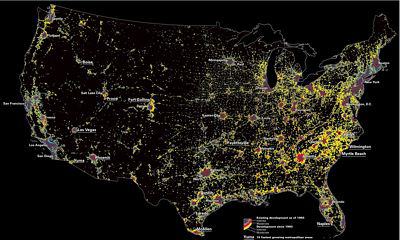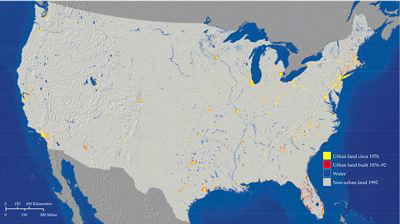No Light Rail in Vancouver!
Just How Bad Is Sprawl?

Back in 2001, National Geographic published an article on urban sprawl. The magazine included a map that purported to show the extent of sprawl in the U.S.
Click on the map to download a printable pdf.
At the time, I described this map as a deceptivegraphc because it greatly exaggerated
the extent of urban development. For example, the map showed that one-
Recently, someone brought my attention to a new (actually, 2005) paper from the University of Toronto that used satellite data to actually measure the extent of development in the U.S. Two datasets were used: one for 1976 and one for 1992. The map they created was very different from the National Deceptivegraphic map.
Click to download a printable pdf of the map (which is taken from the fifth page of the University of Toronto paper).
The University of Toronto paper also found that “the extent of sprawl remained essentially unchanged between 1976 and 1992.” Actually, the paper found that 1.29 percent of the nation was urbanized in 1976, which increased to 1.92 percent in 1992.
Now, the 1990 Census found that 1.7 percent of the nation was in urban areas of 50,000 people or more. By 2000, this had increased to 2.0 percent. When urban clusters of 2,500 people or more are added, the total increases to 2.6 percent. None of these numbers sound very threatening.
Perhaps more interesting is a table on page 14 of the paper that measures a “sprawl index” for the top 50 urban areas in 1976 and 1992. The index varies a lot from urban area to urban area, but between the two years, the index is almost identical in all urban areas. This suggests that sprawl has not seriously increased since 1976.
8
Trackback • Posted in Regional planning
Reprinted from The Antiplanner

